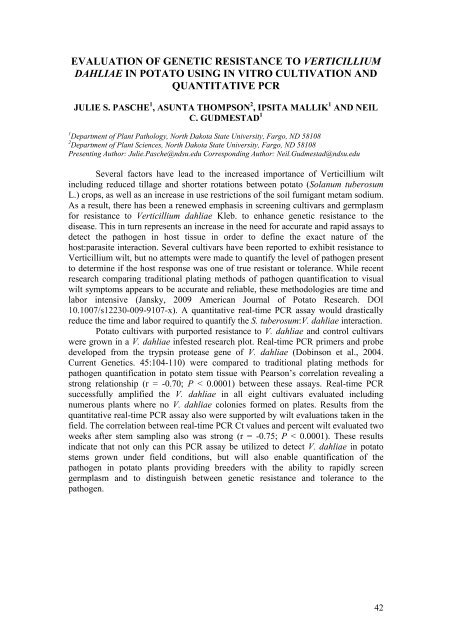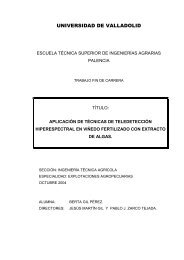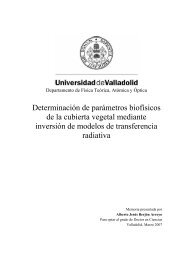10th INTERNATIONAL VERTICILLIUM SYMPOSIUM 16-20 ...
10th INTERNATIONAL VERTICILLIUM SYMPOSIUM 16-20 ...
10th INTERNATIONAL VERTICILLIUM SYMPOSIUM 16-20 ...
Create successful ePaper yourself
Turn your PDF publications into a flip-book with our unique Google optimized e-Paper software.
EVALUATION OF GENETIC RESISTANCE TO <strong>VERTICILLIUM</strong>DAHLIAE IN POTATO USING IN VITRO CULTIVATION ANDQUANTITATIVE PCRJULIE S. PASCHE 1 , ASUNTA THOMPSON 2 , IPSITA MALLIK 1 AND NEILC. GUDMESTAD 11 Department of Plant Pathology, North Dakota State University, Fargo, ND 581082 Department of Plant Sciences, North Dakota State University, Fargo, ND 58108Presenting Author: Julie.Pasche@ndsu.edu Corresponding Author: Neil.Gudmestad@ndsu.eduSeveral factors have lead to the increased importance of Verticillium wiltincluding reduced tillage and shorter rotations between potato (Solanum tuberosumL.) crops, as well as an increase in use restrictions of the soil fumigant metam sodium.As a result, there has been a renewed emphasis in screening cultivars and germplasmfor resistance to Verticillium dahliae Kleb. to enhance genetic resistance to thedisease. This in turn represents an increase in the need for accurate and rapid assays todetect the pathogen in host tissue in order to define the exact nature of thehost:parasite interaction. Several cultivars have been reported to exhibit resistance toVerticillium wilt, but no attempts were made to quantify the level of pathogen presentto determine if the host response was one of true resistant or tolerance. While recentresearch comparing traditional plating methods of pathogen quantification to visualwilt symptoms appears to be accurate and reliable, these methodologies are time andlabor intensive (Jansky, <strong>20</strong>09 American Journal of Potato Research. DOI10.1007/s12230-009-9107-x). A quantitative real-time PCR assay would drasticallyreduce the time and labor required to quantify the S. tuberosum:V. dahliae interaction.Potato cultivars with purported resistance to V. dahliae and control cultivarswere grown in a V. dahliae infested research plot. Real-time PCR primers and probedeveloped from the trypsin protease gene of V. dahliae (Dobinson et al., <strong>20</strong>04.Current Genetics. 45:104-110) were compared to traditional plating methods forpathogen quantification in potato stem tissue with Pearson’s correlation revealing astrong relationship (r = -0.70; P < 0.0001) between these assays. Real-time PCRsuccessfully amplified the V. dahliae in all eight cultivars evaluated includingnumerous plants where no V. dahliae colonies formed on plates. Results from thequantitative real-time PCR assay also were supported by wilt evaluations taken in thefield. The correlation between real-time PCR Ct values and percent wilt evaluated twoweeks after stem sampling also was strong (r = -0.75; P < 0.0001). These resultsindicate that not only can this PCR assay be utilized to detect V. dahliae in potatostems grown under field conditions, but will also enable quantification of thepathogen in potato plants providing breeders with the ability to rapidly screengermplasm and to distinguish between genetic resistance and tolerance to thepathogen.42




